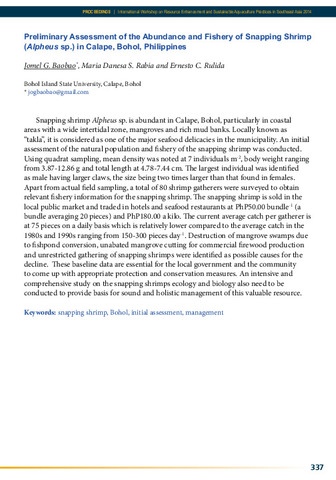Preliminary assessment of the abundance and fishery of snapping shrimp (Alpheus sp.) in Calape, Bohol, Philippines
| dc.contributor.author | Baobao, Jomel G. | |
| dc.contributor.author | Rabia, Maria Danesa S. | |
| dc.contributor.author | Rulida, Ernesto C. | |
| dc.contributor.editor | Romana-Eguia, Maria Rowena R. | |
| dc.contributor.editor | Parado-Estepa, Fe D. | |
| dc.contributor.editor | Salayo, Nerissa D. | |
| dc.contributor.editor | Lebata-Ramos, Ma. Junemie Hazel | |
| dc.date.accessioned | 2016-01-20T17:42:42Z | |
| dc.date.available | 2016-01-20T17:42:42Z | |
| dc.date.issued | 2015 | |
| dc.identifier.citation | Baobao, J. G., Rabia, M. D. S., & Rulida, E. C. (2015). Preliminary assessment of the abundance and fishery of snapping shrimp (Alpheus sp.) in Calape, Bohol, Philippines. In M. R. R. Romana-Eguia, F. D. Parado-Estepa, N. D. Salayo, & M. J. H. Lebata-Ramos (Eds.), Resource Enhancement and Sustainable Aquaculture Practices in Southeast Asia: Challenges in Responsible Production of Aquatic Species: Proceedings of the International Workshop on Resource Enhancement and Sustainable Aquaculture Practices in Southeast Asia 2014 (RESA) (p. 337). Tigbauan, Iloilo, Philippines: Aquaculture Department, Southeast Asian Fisheries Development Center. | |
| dc.identifier.isbn | 9789719931041 | |
| dc.identifier.uri | http://hdl.handle.net/10862/2804 | |
| dc.description | Abstract only. | |
| dc.description.abstract | Snapping shrimp Alpheus sp. is abundant in Calape, Bohol, particularly in coastal areas with a wide intertidal zone, mangroves and rich mud banks. Locally known as takla , it is considered as one of the major seafood delicacies in the municipality. An initial assessment of the natural population and fishery of the snapping shrimp was conducted. Using quadrat sampling, mean density was noted at 7 individuals m-2, body weight ranging from 3.87-12.86 g and total length at 4.78-7.44 cm. The largest individual was identified as male having larger claws, the size being two times larger than that found in females. Apart from actual field sampling, a total of 80 shrimp gatherers were surveyed to obtain relevant fishery information for the snapping shrimp. The snapping shrimp is sold in the local public market and traded in hotels and seafood restaurants at PhP50.00 bundle-1 (a bundle averaging 20 pieces) and PhP180.00 a kilo. The current average catch per gatherer is at 75 pieces on a daily basis which is relatively lower compared to the average catch in the 1980s and 1990s ranging from 150-300 pieces day-1. Destruction of mangrove swamps due to fishpond conversion, unabated mangrove cutting for commercial firewood production and unrestricted gathering of snapping shrimps were identified as possible causes for the decline. These baseline data are essential for the local government and the community to come up with appropriate protection and conservation measures. An intensive and comprehensive study on the snapping shrimps ecology and biology also need to be conducted to provide basis for sound and holistic management of this valuable resource. | |
| dc.language.iso | en | en |
| dc.publisher | Aquaculture Department, Southeast Asian Fisheries Development Center | en |
| dc.subject | Snapping shrimp | |
| dc.subject | Bohol | |
| dc.subject | Initial assessment | |
| dc.title | Preliminary assessment of the abundance and fishery of snapping shrimp (Alpheus sp.) in Calape, Bohol, Philippines | en |
| dc.type | Conference paper | en |
| dc.citation.spage | 337 | |
| dc.citation.conferenceTitle | Resource Enhancement and Sustainable Aquaculture Practices in Southeast Asia: Challenges in Responsible Production of Aquatic Species: Proceedings of the International Workshop on Resource Enhancement and Sustainable Aquaculture Practices in Southeast Asia 2014 (RESA) | en |
| dc.subject.asfa | management | en |


